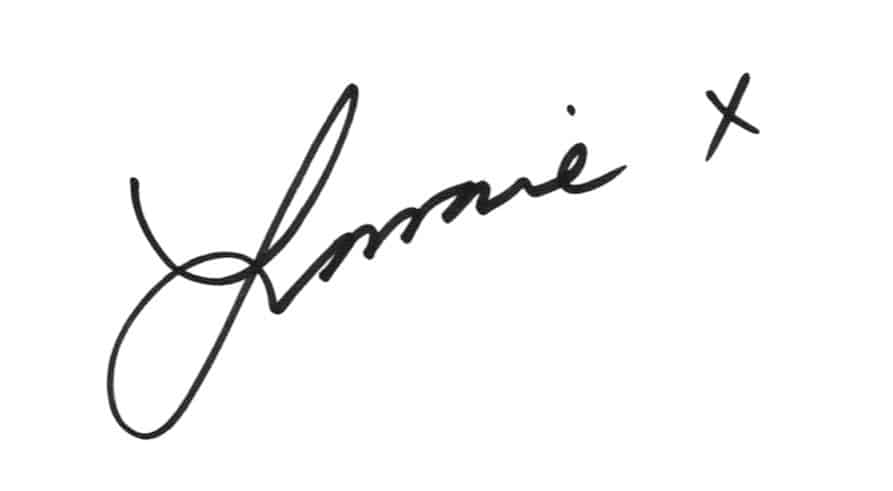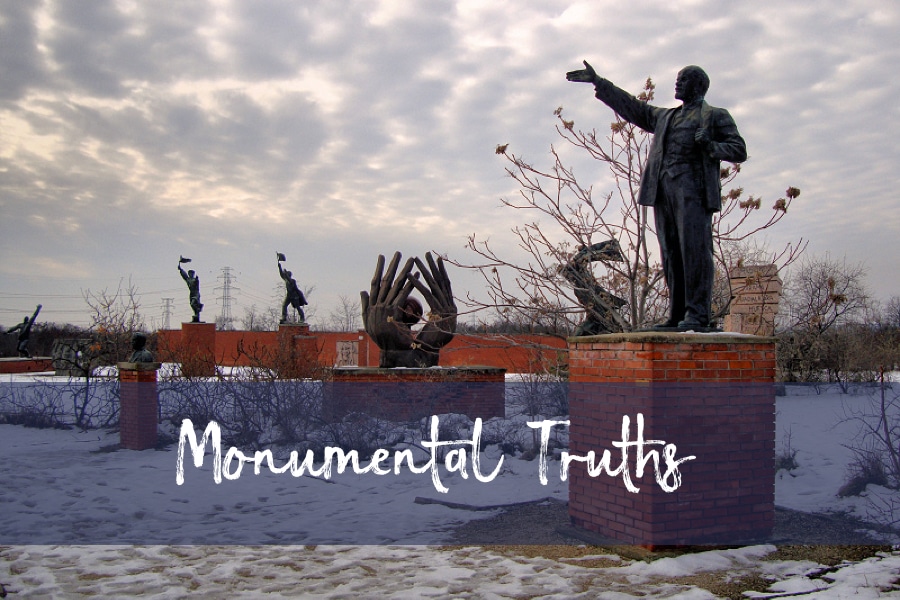
Monumental Truths
Home / Blog / cinnamon colour / Monumental Truths
So many major events have hit the world hard in the last few months, it’s been hard to concentrate on the day to day when life as we know it is in flux. The most recent and highly charged of these events has been a series of horrific incidents of racism and in response, protests resulting in the dismantling of certain commemorative statues. When passions runs high, they ignite so many interesting debates and I’ve spent the last couple of weeks reading, listening and chatting (ok sometimes arguing) with people on social media from all walks of life from around the world. Amongst many other things, we’ve debated how something as inanimate as a statue can bring out so much anger and hatred, the toppling of which is even considered by some to be vandalism or an ‘erasing’ of history. That the space that these statues take up in our public areas and consciousness is now so controversial makes perfect sense to me. I thought I’d share my perspective having worked for many years in the field of public art; how these objects come into existence and how our built environment is shaped by our thinking, structure as a society and cultural status.
For the last couple of decades I’ve been immersed in this world, surrounded by fellow artists, all of us trying to observe and make visual comments on the world around us because that’s what artists do. The way you articulate your ideas and what you want other people to think about or see in your work is done through choice of material, construction method, subject matter and possibly most importantly how you display or present it. At art school we were taught to be very conscious of all of these things when coming up with a proposal for an artwork.
To set some context, I graduated in the mid nineties at a time when life-like figurative sculpture was not at all in fashion and more conceptual work (where ‘it’s all about the idea darling!’) was all the rage. We called it the ‘scratchy drawers’movement – put a smudge on the wall, stand back, look thoughtful and call it art – easy (I jest – well kind of). Meanwhile there was a tug of war going on about the role and scope of art in public places that I found a bit more intriguing. I’d just come back from Florence, Italy – completely inspired by the art filled squares and streets. The intricate buildings with powdery painted frescoes, glowing in the Italian sun captured my heart. I loved that the local people lived so casually beside such incredible and accomplished art and although of course they were proud of it, it wasn’t a big deal -just their heritage wrapped around their buildings in the most comforting and meaningful way.
The reason this was a revelation to me is that at the time there was a strong undercurrent amongst artists in the UK that reeled against the traditional sense of public art (more specifically statues and monuments). If the seventies had brought us abstract blobs in city centres, the late nineties through late noughties brought a massive wave of urban regeneration projects to supposedly improve neglected areas of our cities. These vast developments relied on planning permission that could be granted on the condition that some sort of environmental ‘green token’ was given back to ‘the people’. A flurry of public art commissioning began to emerge, appearing in the small print of legal agreements for urban development with the required promise of community consultation and involvement. Everyone would win.
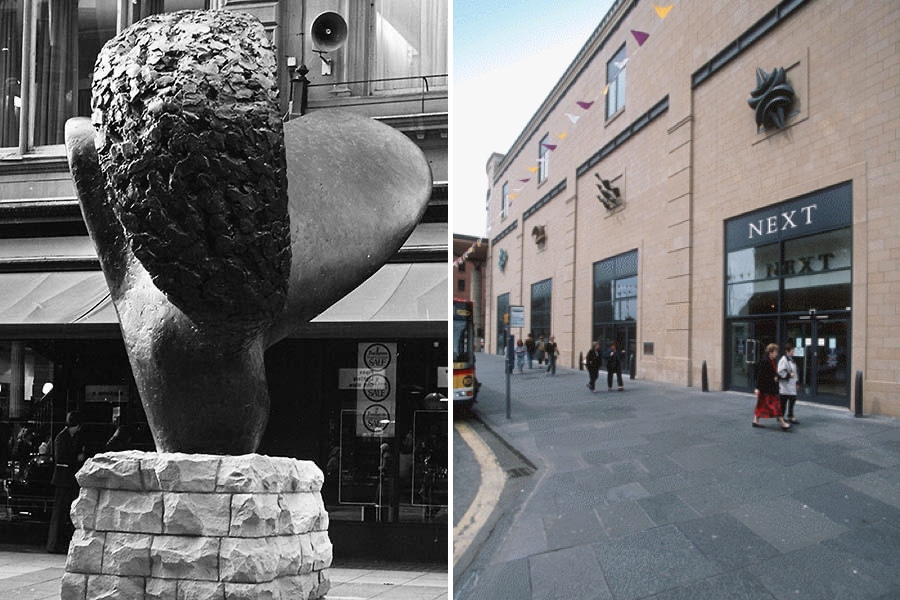
Image: Scottish Media Newspapers
Various works by David F.Wilson Overgate Shopping Centre, Dundee 1999 Image D.F Wilson
But commissioning public art has always been a cumbersome process for both commissioner and artist. The client or commissioner (usually a council, trust or private developer, unless they have the foresight to use a good public art consultant) has to come up with a brief, budget and location, then find the right artist through a fair and inclusive selection process – onerous and time consuming but very necessary for good results.
Consultation itself has to be understood as not a ‘design by committee’ approach but the opportunity for the local community to input into the brief given to the artist so that he or she can then build these parameters into his or her research and design process. Like the ingredients of a good cake. The more time spent on this preparation, the better the outcome. It’s no surprise then, that as deadlines press and budgets diminish, creative thinking goes out of the window.
With regeneration moving fast, consultation with local communities was often shelved and ‘open’ calls to an inclusive mix of artists was more often than not substituted with a well-worn shortlist of reliable will-come-up-with-the-expected-goods-and-not-be-controversial public artists. Artist briefs were often scrambled together by project managers (out of touch with the community issues, values or aspirations) given a strict set of rules by their boss for the types of acceptable art that should be encouraged to show off the ’vision’ for a new kind of place.
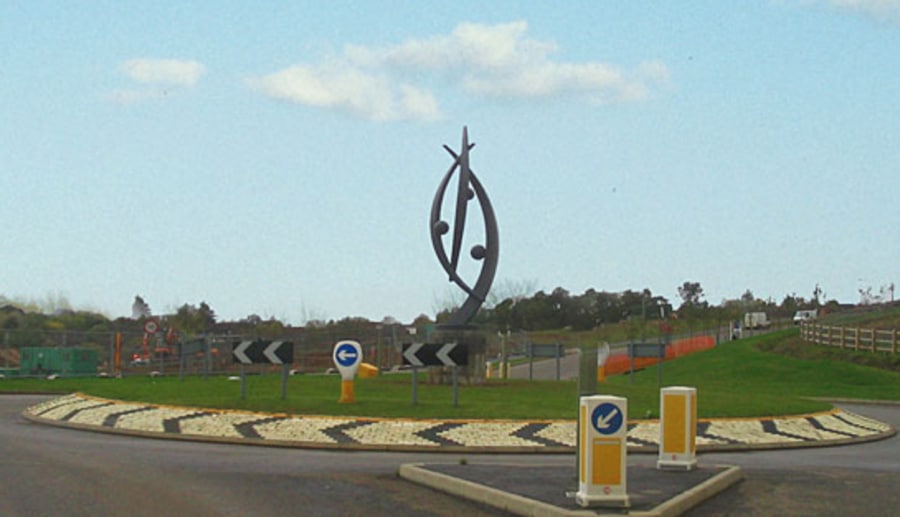
As a result, quite odd looking objects began to pop up on roundabouts, town squares and yes, on plinths. These ‘decorative baubles’ parachuted in at the end of a regeneration project with all the forced pomp and ceremony of a medieval public hanging became the norm. Aftercare plans were rarely thought about and at best these sculptural objects, statues and monuments became worn and unkept, cloaked in graffiti or at worst, ignored completely as meaningless trinkets plonked on the urban landscape.
Communities and artists alike began to reject the whole process and so called ‘public’ art was frequently branded a waste of public money and even a dirty word amongst us artists. We’d joke about how long it would take before a recently so called ‘public’ artwork would be vandalised. I think the record was three hours after the last nut and bolt was tightened. It was a truly unimaginative masterclass in gagging creative expression that completely annihilated the role of the artist and disassociated the local community.
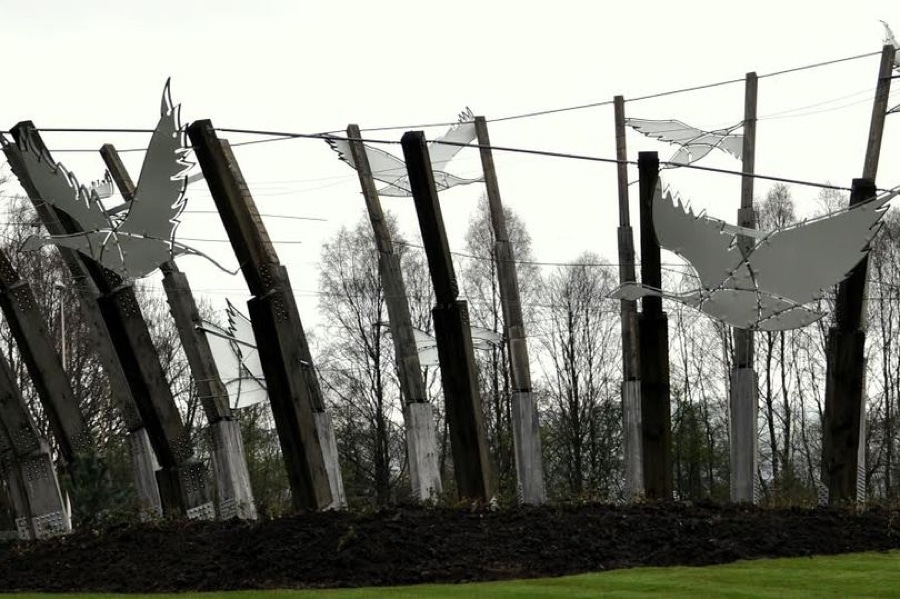
There were exceptions of course. Artists and commissioners who managed to introduce public art that challenged the whole process and concept. Some artists navigating their way through the bureaucracy and red tape, some commissioners putting in the time and effort to put something really worthwhile and thought provoking out there.
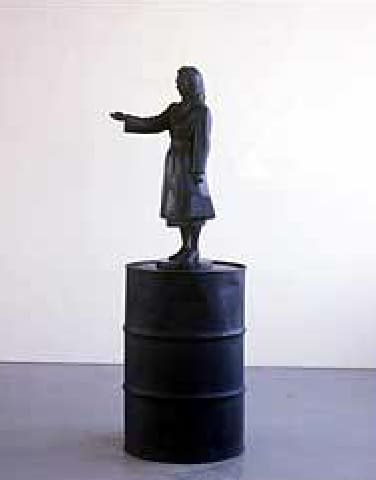
One that comes to mind for me is Kenny Hunter, a Scottish artist whose smooth, perfectly formed sculptures play on the formality of nineteenth century classical statues and monuments but embody a cryptic edge that explores modern society current affairs. His statue of Margaret Thatcher, cast in fibreglass resin with coal dust embedded in it and set on top of an oil drum was an especially charged piece of work.
Hunter’s ‘Citizen Firefighter’ erected outside Central station in Glasgow was the result of an intense research period by the artist in collaboration with the commissioner ( the Scottish Fire And Rescue Service) – many weeks of going out on shifts with real fire-fighters, listening to their stories and physically experiencing what it was like to wear the heavy gear while, climbing stairs in a burning building. His final artwork has no visible face – hidden behind a helmet and visor with breathing apparatus – it could be a man or woman and of any race. Erected not on a plinth, but at ground level, presented as any and every one of us. It commemorates the family of firefighters and those who have died in service, a really powerful piece and well accepted by the people of Glasgow. You can see here it’s sometimes used for messages of community support and solidarity.
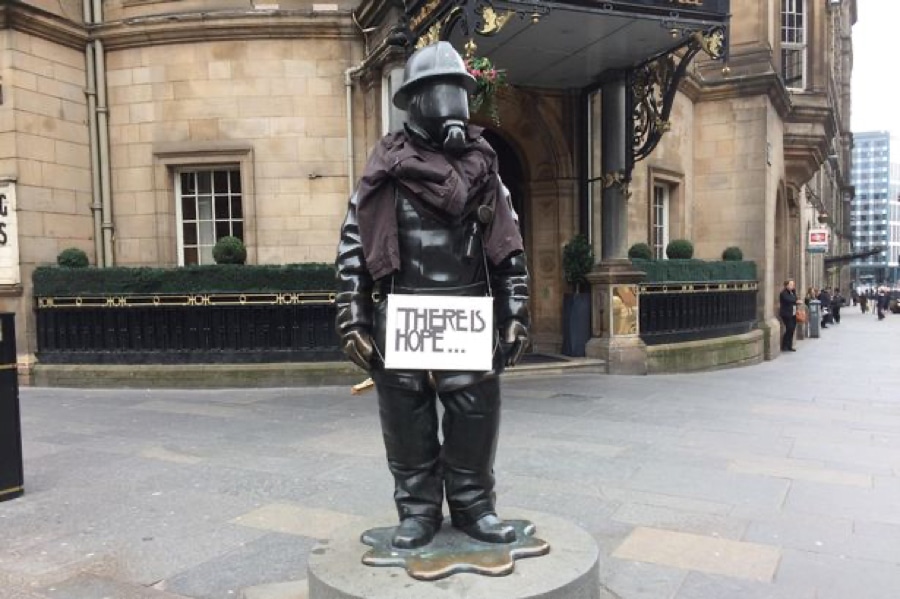
Another truly inspirational example of challenging the space taken up by public monuments is ‘The fourth Plinth’ project in Trafalgar Square, London. This was a plinth originally intended for a public statue of William IV and his horse in the early 1800’s but the funds weren’t found and it lay empty for over a century. In 1998, in a new wave of public art fever, Prue Leith, then chair of the Royal Society of Arts came up with the inspired idea to have a changing display of commissioned provocative public art beginning in 1999 with a giant sculpture by Mark Wallinger, ‘ Ecce Homo’. The sculpture presented a modern day figure of Jesus Christ – a small man standing on the giant plinth intended by the artist to appear exposed and vulnerable. It represented any person facing hostility for speaking out about what they believe in.
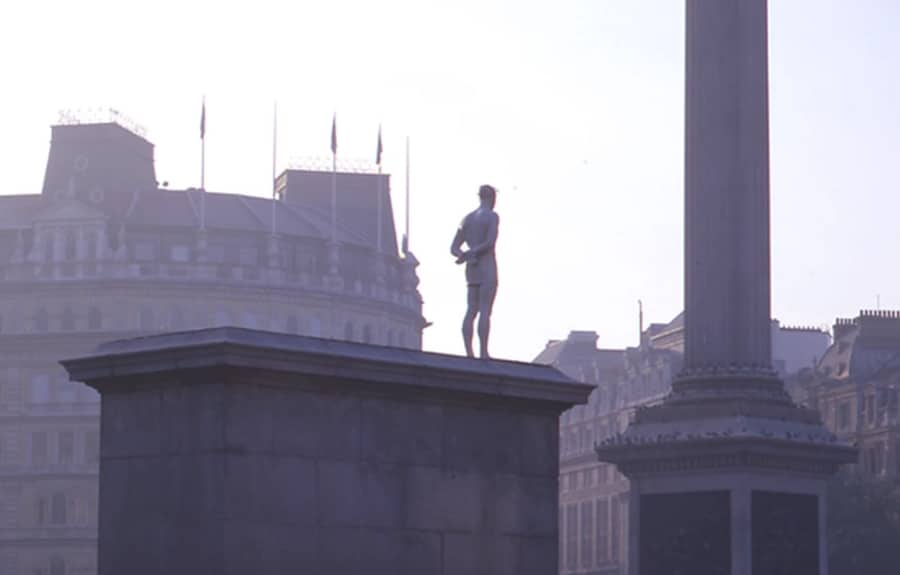
This was followed by other works such as Marc Quinn’s ‘Alison Lapper Pregnant’, questioning ideas of beauty, the form of the human body. On his approach to making the sculpture of Alison – an English artist with phocomelia ( born without arms and shortened legs) – Marc commented, ‘Marble is the material used to commemorate heroes, and these people seem to me to be a new kind of hero – people who instead of conquering the outside world have conquered their own inner world and gone on to live fulfilled lives. To me, they celebrate the diversity of humanity. Most monuments are commemorating past events; because Alison is pregnant it’s a sculpture about the future possibilities of humanity.” – Marc Quinn, Recent Sculptures Catalogue, Groninger Museum, 2006 .
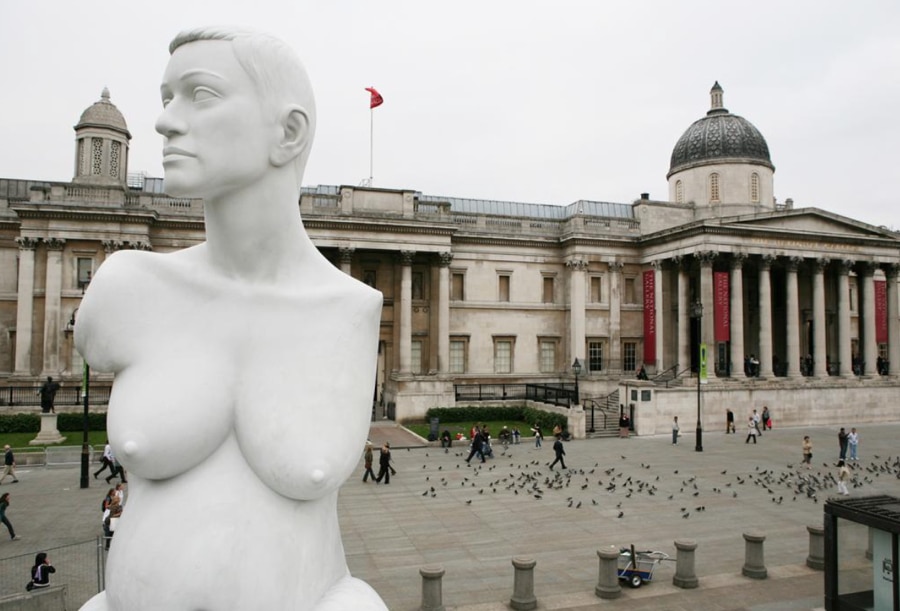
Another artist Yinka Shonibare created ‘Nelson’s Ship In A Bottle in 2010 – to commemorate the battle of Trafalgar and was the first black artist to be commissioned to produce a piece of public art for the plinth. This piece made references to Britain’s colonial past with African print fabric used on the sales of the ship, officially to celebrate Nelson’s expansion of the British Empire but possibly to remind us of the cost of this imperialist journey. This was a hugely respected piece and after much public fundraising to avoid private sale, it’s now in the Maritime museum in London. The commissioning of temporary public art for the Fourth Plinth continues to this day.
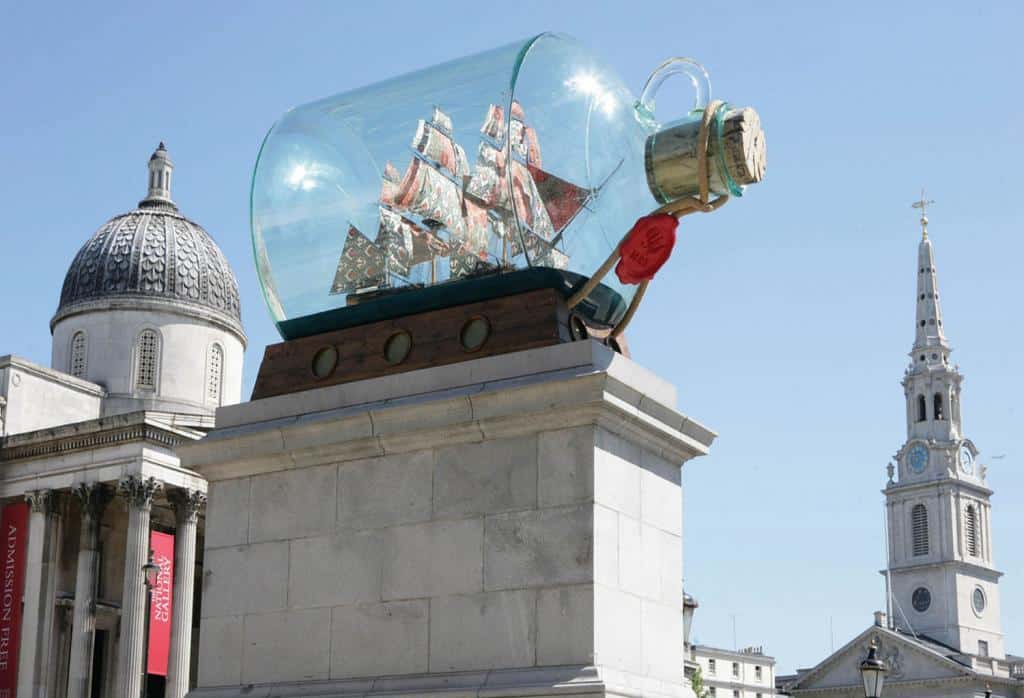
Art and buildings have always had a strong relationship in shaping city identities and forms. Buildings have historically signalled their purpose by their form and grandeur or lack of – think farm buildings, government headquarters, civic halls and the ever-rocketing gleaming skyscrapers that celebrate financial power.
More sinister examples are the Nazi facist architecture of the 1900’s designed as overwhelming symbols of dominance, uniformity and oppressive ideologies aimed to crush the independent thinker. Buildings change the shape of our cities and tell much about the people that live there. Sculpture can contribute greatly but statues take up quite a different space in our shared environment.
Early ancient cultures created large scale buildings and sculptures for gods they worshipped or important religious icons and made them prominent in the landscape or their city. It was seen as a symbol of their culture, common values and human spirit. Later the Greeks and Romans with strong hierarchical societal structures, had life-like statues made of prominent political leaders and businessmen and put them on plinths to honour them with the highest status – that people should look up at them in admiration.
There is a reason for monumental plinths, they add scale and height. The feeling of being small and insignificant next to them and looking up to them is not accidental. This approach to public monuments influenced many of the nineteenth and twentieth century classical statues that have come into question in recent weeks against a very different cultural and social backdrop.
We may have been oblivious to some, as their meaning got lost along the way but now in a time when we are more mindful than ever of the nuances of human nature, culture and lifestyle, it’s dawning on us that there are many sub-histories clearly excluded from the mainstream school curriculum. The singular viewpoint or mono-story presented in the grand display of these statues today is coming under scrutiny and rightly so.
Most would agree that figures of oppression or those that have had a hand in atrocities don’t belong as idolised icons in a ‘civilised’ twenty first century society but destroying them completely some feel, would be erasing a past that did exist. If these key figureheads of our albeit flawed past, bound in stone or bronze are to remain in our shared public spaces where we have no choice but to walk past them everyday staring down at us apathetically, then surely we have a social and cultural responsibility to ensure we present publicly, the full story, good and bad, in order to preserve history – if that’s what we’re worried about. Or, and it’s a difficult but practical question, if we remove them, what can we do with them aside from flinging them to the bottom of a river – not the most environmentally responsible action.
One possibility comes to mind. Just before we set up Curious Egg, we spent a whole summer travelling around Europe exploring cities and villages. One of my most vivid memories is of a special and unique site in Budapest Hungary – Memento Park. I would describe it as an outdoor museum or ‘statue graveyard’ set in the outskirts of the city within easy reach but not in the main civic spaces. They have created a small park with a maze-like path winding around a mapped route. Here you’ll discover all the toppled and decommissioned statues dismantled and removed from public plinths around the city, mostly key figures from the Communist era and Red Army occupation.
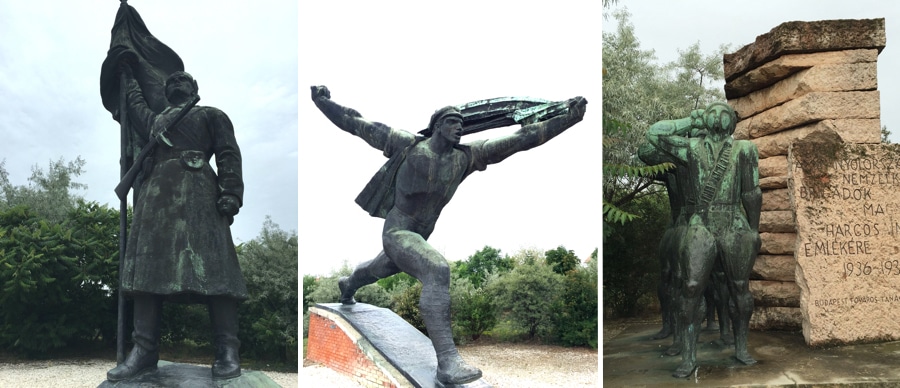
It’s a haunting and yet slightly magical experience, a little like going to an amusement park without the rides but with all the theatre. It’s not overly styled or explained, not many other props or amenities, just the statues – some poignant, some downright malevolent looking. You pay a small fee to go in and with that, you know you will be presented with a city’s true past, warts and all. As with an art gallery, you can’t object as there should be no censorship as long as the museum isn’t pushing any particular agenda and you’ve chosen to go in. Each statue displays a fragment of history – the attitudes and values of a city’s people at a particular moment in time and I think that allows for proper refection, discussion and learning.
“This Park is about dictatorship and at the same time, because it can be talked about, described and built up, this Park is about democracy. After all, only democracy can provide an opportunity to think freely about dictatorship or about democracy, come to that! Or about anything!” Architect Ákos Eleőd, conceptual designer of Memento Park
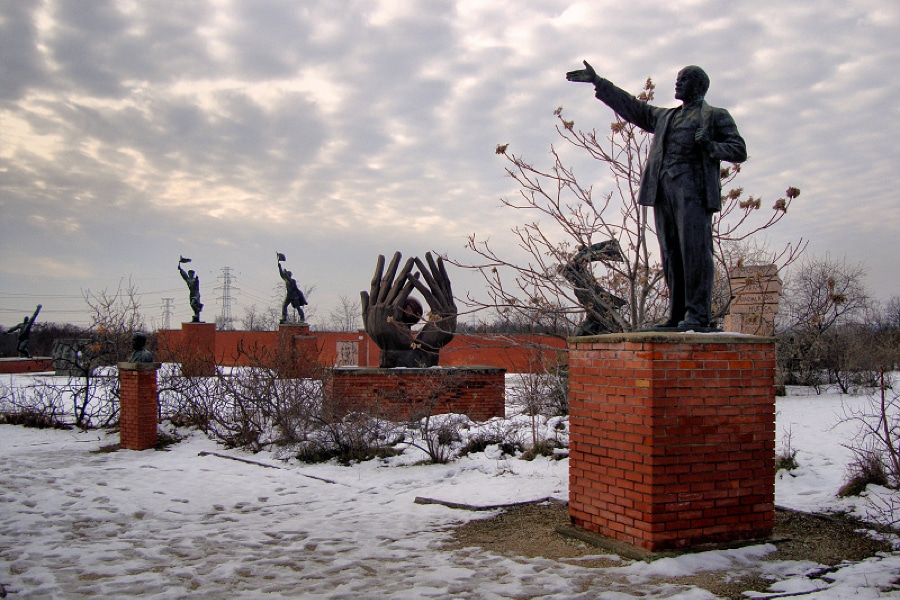
Our most personal space is that within our home – a place that houses objects that tell a story of our past and present identity. Just as our personal story changes as we mature, our homes change to reflect our current tastes, values, habits, outlook and memories. We may cringe at (or truly regret) past behaviour and actions so probably wouldn’t choose to have it all on display as an everyday reminder but few of us would destroy all of those mementos completely… however shameful they may be. We might place them in a box for occasional reference so that we don’t let ourselves forget who we once were and did and what we learned from those experiences and mistakes -hopefully becoming better people as a result.
Maybe if we think of our cities as our outdoor homes, the same applies. If we agree that culture is fluid, then as humanity matures, can our cities and shared public spaces reflect this fluidity too? Do monuments and statues have a place at all and if so, if we are to look up at them in pride and admiration, could they represent more timeless virtues that we, as a forward looking society can all feel good about – virtues such as equality, tolerance, mutual care, kinship and curiosity those elements of human life that tap into our collective soul?
Could we then use the most significant outdoor public spaces for temporary displays – strong, intelligent and complex artworks in all mediums – that question and explore the controversial or challenging within our communities as initiated in the ‘Fourth Plinth’ Commission. This kind of approach could ensure that public space is preserved for open and equal opportunity ( in proposing new works) and for inclusive public comment and debate – they would be cultural sentinels of our times, documented… but fluid.
“The art of life lies in a constant readjustment to our surroundings” – Kakuzo Okakura, The Book of Tea.
